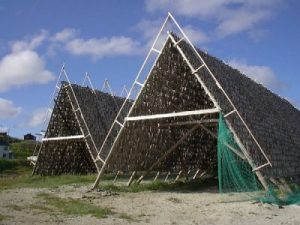
Norwegian women – answered the question of Lilla Bulyovszky a Bergen woman with venomous tongue – ”are lean like herring, but still look more like dried cod”. The Hungarian actress visited Norway with a Polish family in 1864 and experienced the poverty of rural people. Hospitality was mostly limited to butter and eggs, and the feast was rich if fish was on the table. “Without fish, one could starve to death in this wonderful country; but fortunately there are hardly any places without water, and there is fish in all of them. People go to a stream, river, lake or to the sea to fish like we go to the back yard for a hen or duck.” – she wrote. Meals were based on dried fish in many places. After soaking, it was cooked and possibly consumed with a pulp made from bread brewed in beer (also an 800-year-old recipe).
Remains of a dried catfish have been found among the wreckage of a 2400-year-old Greek ship. However, our picture was taken a few years ago: it shows a carefully assembled pile of cod removed from drying racks on the Norwegian island of Langøya. (These are referred to as “stockfish,” referring to the rods on the drying rack.) After being dried by the sun and wind from January to May, the oldest method of preservation, the fish can be used for several years. Of course, only if bacteria or parasites do not multiply in it, seagulls do not pinch it, rats do not chew it, and so on. Dried fish loses 70% of the moisture content of fresh fish, but retains concentrated proteins, vitamin B, iron and calcium. Its preparation involves a lot of hassle: you have to store and water it in a cool place for a week, soaking it before you start cooking.

Dried fish was an important export product. It was first transported to England by Torolv Kveldulvsson in 875. In the following centuries Norwegian fish trade flourished, and the city of Bergen, which enjoyed a monopoly, became particularly rich. As early as 1444, perhaps for the first time in the world, a royal decree regulated the control of the quality of dried cod, and classified it into 24 classes. The best ones were sold to Western and Southern Europe, while poorer quality fish remained for the local people.
Although Marx Rumpolt, the famous chef of the 16th century, wrote in his cookbook of 1581 that all countries need dried fish with the exception of Hungary, abundant in fresh fish, where it is simply called a “stinky beast”, drying was actually used for preservation in Hungary, too. In her cookbook (1680) Anna Bornemissza gave twelve recipes from “stokfish” following Rumpolt.
Éva Orbán
Originally published: Orbán Éva: Szárított hal Langoya-szigeten. Magyar Állatorvosok Lapja, 2021. 143. 10. 578.
Source of the image “fish-drying rack”: https://hu.wikipedia.org/wiki/F%C3%A1jl:Hjell-oversikt.arj.jpeg

